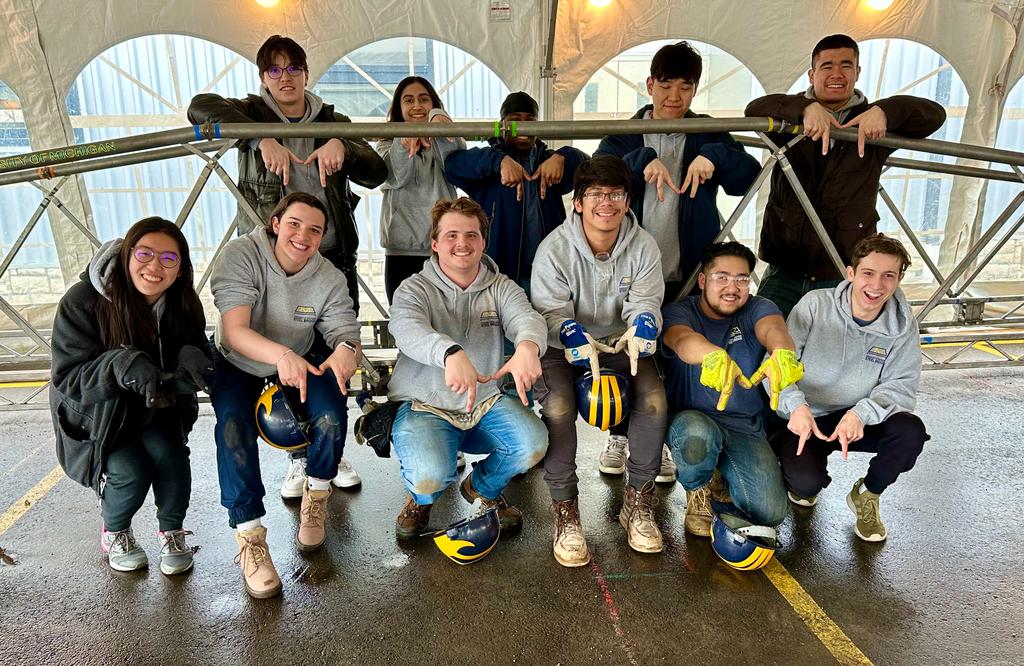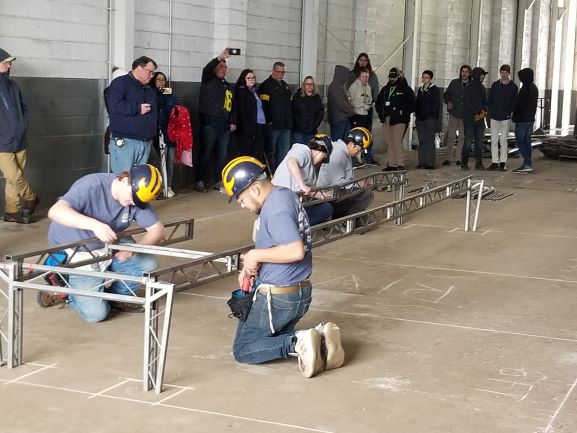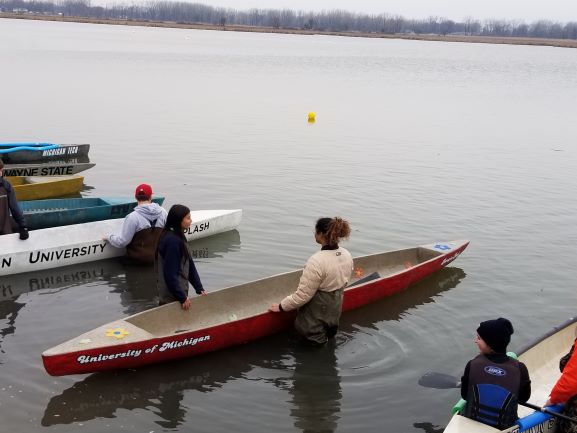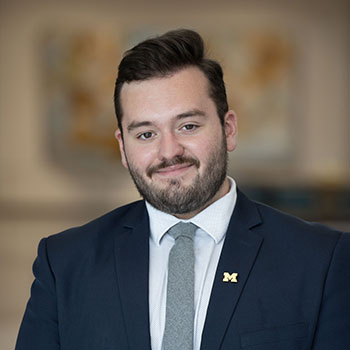
U-M Steel Bridge, Concrete Canoe Teams Forge Strong Support Through Collaboration
The U-M Steel Bridge Team is on its way to national competition at UC San Diego on June 2-3.

The U-M Steel Bridge Team is on its way to national competition at UC San Diego on June 2-3.
The U-M Student Steel Bridge and Concrete Canoe teams practice at the Wilson Center on campus and are organizations that provide extensive opportunities for students to gain teamwork, leadership and practical skills in a variety of civil engineering applications. These two groups have a collaborative relationship that spans their areas of expertise.
The Student Steel Bridge Team will be competing at the National Finals on June 2-3 at UC San Diego, along with top teams who won at 20 regional competitions throughout North America this spring.
The U-M team clinched its trip to San Diego in late March during the Eastern Great Lakes Regional Competition, which Wayne State University in Detroit hosted. The top two teams out of 13 were guaranteed a slot at Nationals. Youngstown State in Ohio and U-M will represent this region.

Arriving at Nationals with an award-winning bridge doesn’t happen overnight. The competition is actually a year-long process, with hundreds of hours of work going into the planning, organizing and constructing of the bridge. Two members of U-M’s Steel Bridge Team, Captains Emma Remien and Benjamin Poole, discussed behind-the-scenes details that culminated in their 2nd-place regional victory.
“The first time you put the bridge together, you realize how exciting this is,” Remien said. “You see the progression of how this started as a little diagram on a screen to a 24-foot-long metal structure. You just want to say, ‘This is impressive, team! Good job!’ ”
Throughout the process, the team has to consider the practicality of its design. During the competition, team members will have to construct smaller pieces of the bridge into larger ones within a specified timeframe.

“We generally spend the whole fall designing our bridge, and the winter semester is pretty much all fabrication. We design one bridge for an entire yearly competition cycle,” Remien said. “In the first couple of months, we use structural analysis software and iterate different designs that people develop as we all contribute ideas. We then model the structure in a 3D-CAD software program. The design is changed according to constraints we encounter and, of course, the rules, which change significantly from year to year. We have to start from scratch every September when the new rules are released. During those early meetings, we get together three or so times a week and go through a design process of spitting out ideas, testing them by seeing how they will react to loads and continuously redesigning until we are happy with the final product.”
“We always have to keep in mind how constructable the design is, how easy it is to fabricate, whether we have the facilities needed to fabricate the parts, and many other considerations,” Remien added.
U-M’s Steel Bridge Team consists of about 15 to 18 active members. The group reaches out to students in a variety of majors, but most members are in civil engineering. Students have the opportunity to focus on an area of specialization they enjoy, but are encouraged to explore a variety of tasks to expand their knowledge and experience. Remien noted that any software can be learned, so team leaders are supportive of newcomers to programming. “We understand that some of our team members may not be familiar or comfortable with a new program, but we are willing to walk them through it step-by-step,” she said. “Participating in Steel Bridge is a valuable process because we are getting experience with different software that we likely will be using in our future careers.”
Remien also noted that students can devote as much time as they choose to the team. “We are completely open and understanding when people have other commitments,” she said. “We provide a flexible environment where students can gain experience in a way they otherwise would be unable to.”
Collaboration is one of the skills students learn as part of their time with the team, and that includes collaborating with members of Concrete Canoe. Steel Bridge’s other captain, Ben Poole, said that the two teams’ members often have overlapping majors, typically in environmental engineering, civil engineering, and materials science and engineering.
“It only makes sense that we help each other out as much as we can, especially toward the end of ramping up for competition,” Poole said. The Steel Bridge Team helped Concrete Canoe build stands to store their canoe and assisted with technical issues involving that task, such as welding and basic woodworking. “They needed extra hands, so we liked doing the work with them because we want both teams to represent the university in the best capacity possible. A lot of us know each other from taking classes together and working in the Wilson Center at the same time. It’s a good opportunity to get to know people in our departments and to develop working relationships between the teams.”
Concrete Canoe Team members noted that close professional ties with Steel Bridge have been a positive factor for both groups. “We’re very integrated with each other, especially since a couple of Concrete Canoe members are also on Steel Bridge,” said Xanthe Thomas, the Concrete Canoe Team Captain. “It’s beneficial to have our teams blended together because what we do is so interconnected. Steel Bridge contributed to our team effort. They provided stands that could hold a 300-plus-pound canoe. Originally, our stands could not do that.”

Concrete Canoe’s team made the stand’s design, and then the Steel Bridge group assisted on the construction drawings and welded them. Although Concrete Canoe will not be traveling to Nationals this year, the group had a successful year, placing third overall in the regional competition, also held at Wayne State.
The team canoe, called Boogie Boat, came in 2nd Place in the Project Proposal category, 1st Place for Oral Presentation, 4th place for Final Prototype, and 3rd place for Paddling Races. “We welcome new members, and will teach people everything they need to know to participate from the ground up,” said Hull Design Lead Vivian Kim. The Concrete Canoe Team uses CAD software in the design process.
COVID-19 created complications and hurdles with traditional schedules and plans, and it was no different for the Concrete Canoe Team. When competitions resumed, only three returning members knew how to pour a canoe. To assist in future knowledge transfer, team members have written instructions that can be shared with incoming members so that each group does not have to start from scratch, whether in the pouring process or in software programming.
As with Steel Bridge, the Concrete Canoe Team begins work on the next year’s competition almost as soon as the current year’s competition ends. Members prepare for the new season for five to six months, laying the groundwork for “Casting Day,” which happens in January. Some of the advance work before Casting Day includes designing the mold, testing, modeling and contacting the sponsor to manufacture the mold, followed by creating the concrete mixes.
“We make about 18 concrete mixes and then test them for different properties,” Thomas said. “After mixing, we decide which ones will be the best for strength, low density and safety factors.”
Gigi Nassir is the Aesthetics Lead for the U-M Concrete Canoe Team, and noted that she was able to apply lessons she learned in classes, and vice versa, to her experience with the team. “Everything I learned in mix actually helped me so much with my class,” she said. “Concrete Canoe is a fun activity, but it also helps you with your courses and will assist you in your future professional career.” Nassir’s role of Aesthetics is involved with creating any physical or digital media for the competition. The entire Design subgroup handles the boat modeling design, and then ultimately the manufacturing and preparation of the mold.
Team Captain Thomas agreed about the applicability of skills that team members learn as part of the competition process. “When future employers see Michigan Concrete Canoe on your resume, it gets their attention. These organizations know that people who have been team members will be an asset to them because of the skills they have acquired.”
Thomas added that the Concrete Canoe Team has been active on campus since 1972–more than 50 years. This tradition includes many U-M alumni who forged a strong connection with the team. “A member of our team came in contact with a member from the class of 1972, who actually sent us footage of them sailing the canoes back then, so it was very exciting.”
This year’s team had 30 to 35 members. Various roles have specified tasks to learn and complete. For example, there was a mix design lead and a mix design assistant. The assistant’s role was much like that of an apprentice, according to Thomas. “The job of the apprentice is to learn everything they can to be prepared to become the lead in the future. The role of the lead is to make and design all of the mixes, but also to be in charge of educating all of the members.” In addition to the actual mixing process, the lead is responsible for quality control and assurance. The canoe’s design has to meet all of the requirements listed for the competition, but also has to provide for a canoe that allows for driver maneuverability, turning and safety for those who steer the boat. The level of design detail includes figuring out how the canoe will sit in the water, how deep it will stay in the water and how easily the canoe will tip.
Team Captain Thomas noted that the complexity of the challenge encourages a multidisciplinary approach to problem solving. “We do our best when we have many different perspectives,” she said. “Having different engineering majors represented increases our problem-solving abilities and our adaptability.”

Marketing Communications Specialist
Department of Civil and Environmental Engineering